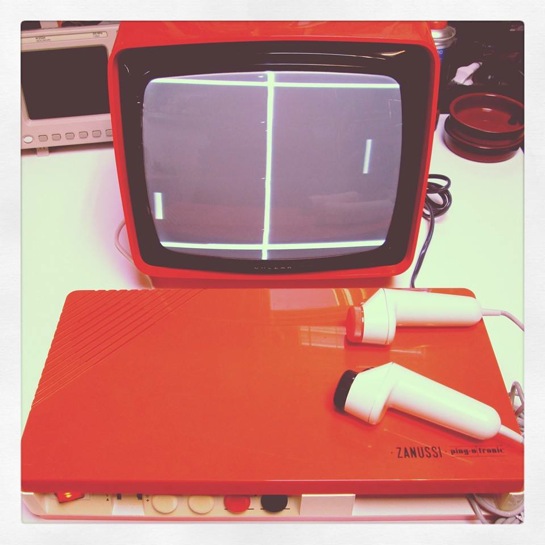Zanussi/Seleco Ping-o-Tronic (1st Edition – 1975)

Autopsy:
Zanussi, a well known Italian furniture company, released two game systems: Ping-O-Tronic, an analog game first released in late 1974 but really successful during 1975, and Play-o-Tronic, an AY-3-8500 game released in 1977 (this particular model was also released by Universum in Germany). Zanussi obtained the Sanders Associates License Agreement on April 21st, 1975. Zanussi reported 21,514 Play-o-Tronic units sold between October 1st and December 31st, 1977 (3 months) for a total amount of 620,408,000 lire, on which a 5.5% royalty was paid to Sanders (34,122,440 lire). Considering this amount, each game would have cost around 28,800 lire during this period, which seems quite low. Unfortunately there is no similar information for Ping-O-Tronic.
Ping-O-Tronic is a nice example of an early video game designed with discrete components (over fifty transistors and twenty diodes) and only three TTL chips (7400 type). All of the graphic objets (paddles, ball, boundaries) and sync signals are generated by transistor flip-flops and one-shots. The chips combine the individual signals so as to manage events like collisions between the ball and a paddle, or a lost ball. They may also be used as triggers for the serves.
 This system is quite interesting because it has been improved and upgraded several times. At least nine different models are known to exist, all of which remain on the initial design (PP-2 if not PP-1). Little is known about the first model (PP-1), which dates late 1974. All we know is that it was nearly same as model PP-2 below, and may differ only by one or a few improvements in the electronic circuits (cleaner video signals, etc).
This system is quite interesting because it has been improved and upgraded several times. At least nine different models are known to exist, all of which remain on the initial design (PP-2 if not PP-1). Little is known about the first model (PP-1), which dates late 1974. All we know is that it was nearly same as model PP-2 below, and may differ only by one or a few improvements in the electronic circuits (cleaner video signals, etc).
All of the systems play three games: Tennis, Squash / Solo and Attract / Automatic. Tennis and Squash are the obvious games played by analog systems. Curiously, the Hole in the Wall variant has not been implemented although it would have required minor modifications to invert the video signal of a paddle (or both to play more games). Surprizingly, an Attract / Automatic mode is available, where nodoby plays. Both paddles take the whole screen in height, forming a closed square with the two horizontal boundaries. Thus the ball bounces indefinitely, making a very strange PONG variant that only one other system known to play: Executive Games Electronic Television Tennis. This mode was a very clever way to attract people in shops because it required nobody to demonstrate the unit. You whould simply place it in the window and everybody walking down the street would see it play by itself ! This said, the attract mode designed by Executive Games was more realistic since it involved an intelligent paddle which moved automatically to always catch the ball in a squash game.
Several adjustments can be made. Paddles can vary in height from very small (almost unplayable) to enormous. This rare feature for an analog game certainly allowed young kids to play more easily. The picture can be centered both horizontally and vertically. The system is only powered by the mains (no batteries). Both hand controllers can be stored in the system case when not used.
Although model PP-2 is labeled Zanussi Ping-O-Tronic on the top side, models PP-4 and PP-5 are known to exist as Seleco Ping-O-Tronic. As a matter of fact, Seleco was a trademark of the Zanussi Industries. Other models like PP-6 only show “Ping-O-Tronic” without trademark. We currently ignore if both Seleco and Zanussi labels were used for a same model.
source: pong-story.com





































Recent Comments